Stories & Legends
 |
 |
 |
 |
 |
 |
 |
The Sword of St. Galgano
Galgano Guidotti was born into a noble family in Chiusdino near Sienna in the year 1148. He became a knight who was famous, sad to say, for his fierce temper, violence and worldly life.
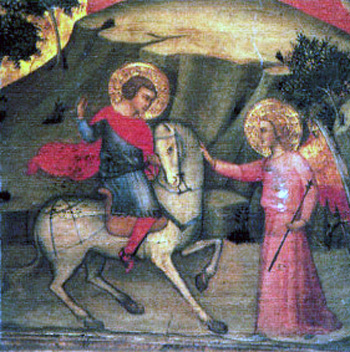 One night the Archangel Michael appeared in a dream to Sir Galgano, who was 32 years-of-age, and beckoned to him to follow, for the Archangel would show him the path to God. The knight, surprised but fearless, followed him down a narrow difficult path to Monte Siepi. Eventually they stopped before a circular-shaped church, outside of which
the Twelve Apostles were standing. They greeted Galgano and told him what he should do and where he should go.
One night the Archangel Michael appeared in a dream to Sir Galgano, who was 32 years-of-age, and beckoned to him to follow, for the Archangel would show him the path to God. The knight, surprised but fearless, followed him down a narrow difficult path to Monte Siepi. Eventually they stopped before a circular-shaped church, outside of which
the Twelve Apostles were standing. They greeted Galgano and told him what he should do and where he should go.
At first Sir Galgano ignored the vision. It was not until some days later when he was out riding that he changed. As he went along his way, his horse suddenly reared and he fell. As he struggled to rise, he felt as if he were being lifted to his feet by invisible hands and then, guided by a seraphic voice, he made his way to Monte Siepi, a rugged hill near Chiusdino.
The voice bade him stop and look up. There, at the top of the hill, was the circular church with Our Lord and Our Lady surrounded by the Apostles. As he climbed the hill, the vision faded. When he reached the top, the voice spoke again, commanding him to renounce all worldly pleasures.
Galgano replied, "Indeed, I would gladly follow your order, but doing so for me would be as easy as splitting rocks with a sword."
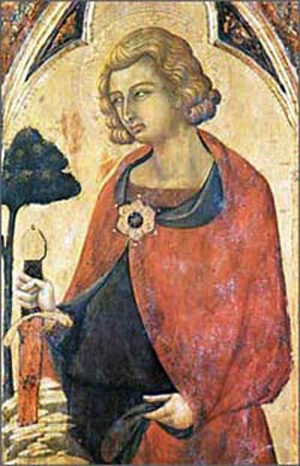
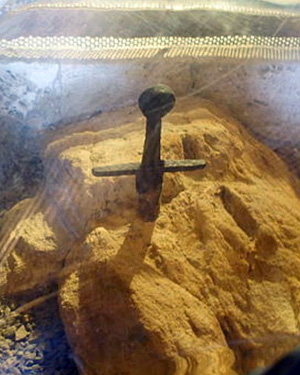 To prove his point, he drew his weapon and struck a nearby rock with all his force, fully expecting the blade to snap. Instead, the weapon penetrated the rock like a hot knife through butter. Galgano never left the hill again. To this day pilgrims can see the cross-shaped sword of St. Galgano – proven to date to the 12th century – embedded to its hilt in a jagged rock that protrudes from the center of the tile floor in the circular end of Montesiepi Chapel.
To prove his point, he drew his weapon and struck a nearby rock with all his force, fully expecting the blade to snap. Instead, the weapon penetrated the rock like a hot knife through butter. Galgano never left the hill again. To this day pilgrims can see the cross-shaped sword of St. Galgano – proven to date to the 12th century – embedded to its hilt in a jagged rock that protrudes from the center of the tile floor in the circular end of Montesiepi Chapel.
Stories spread throughout the area of the hermit knight Galgano who used the rock with the sword as an altar where he prayed. It was said the wild animals were his frequent companions. The local farmers trekked up the hill to talk to him and ask his blessing. Soon, miracles were reported that were worked by his intercession and prayers.
The Devil, who never sleeps and was jealous of the good his former servant was doing, sent an evil man disguised as a monk to kill Galgano. The wolves who had befriended the hermit killed the would-be assassin and gnawed at his bones.
One year after sinking his sword into the stone at Monte Siepi, Galgano died on December 3, 1181 at age 33. By that time, the fame of Galgano was so great that Bishops and Abbots attended the funeral. The next year the Bishop of Volterra gave Monte Siepi to the Cistercian monks to build a shrine to Galgano's memory over his small circular rock hermitage.
The canonization process for Galgano started in 1185, only a few years after his death. The acts of his canonization process are the oldest to have survived, and in them are sworn testimonies of the miracles performed by the Saint, both during his lifetime and after his death.
After Galgano's death, his scalp continued to grow blonde curls for a long time. The miraculous head was placed on one side of the chapel, and the gnawed bones of the arms of the evil man on another. The crowds of pilgrims were so numerous that in 1218 the Cistercians were authorized to build another monastery named after the Saint a short distance away in the plain below the Hermitage.
They built the Abbey of St. Galgano, one of the most beautiful Gothic buildings of Italy. The monastery rapidly became powerful and respected: Monks from San Galgano were appointed to high offices throughout Tuscany.
Sadly, by the 16th century the once famous Cistercian Monastery stood in ruins. However, the semi-circular Montesiepi Chapel survived, still housing the famous sword of St. Galgano, a symbol for all ages of the conversion of the wayward knight, and the gnawed mummified hands of the assassin, a warning to all who would do evil to holy men – or to any who might be tempted to steal St. Gaglano's sword.
There are some who say that it is this sword in Tuscany that led to the myth of the sword in stone in the King Arthur’s legend. The first stories of King Arthur appear decades after Galgano’s canonization in a poem by Burgundian poet Robert de Bron. It has been suggested tales of The Round Table may have been inspired by the round chapel and the name Galgano was altered to become Gawain.
Although Britons are loathe to admit it, it could be that the stories of King Arthur are really based on the true history of an Italian knight-saint.
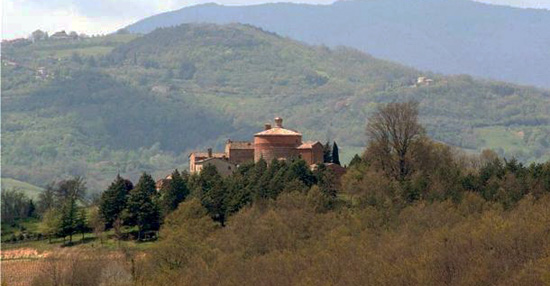

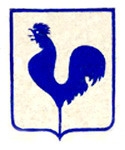

While riding, Galgano is unseated and guided by St. Michael to his vocation
At first Sir Galgano ignored the vision. It was not until some days later when he was out riding that he changed. As he went along his way, his horse suddenly reared and he fell. As he struggled to rise, he felt as if he were being lifted to his feet by invisible hands and then, guided by a seraphic voice, he made his way to Monte Siepi, a rugged hill near Chiusdino.
The voice bade him stop and look up. There, at the top of the hill, was the circular church with Our Lord and Our Lady surrounded by the Apostles. As he climbed the hill, the vision faded. When he reached the top, the voice spoke again, commanding him to renounce all worldly pleasures.
Galgano replied, "Indeed, I would gladly follow your order, but doing so for me would be as easy as splitting rocks with a sword."

The sword of St. Galgano can still be viewed in Montesiepi Chapel

Stories spread throughout the area of the hermit knight Galgano who used the rock with the sword as an altar where he prayed. It was said the wild animals were his frequent companions. The local farmers trekked up the hill to talk to him and ask his blessing. Soon, miracles were reported that were worked by his intercession and prayers.
The Devil, who never sleeps and was jealous of the good his former servant was doing, sent an evil man disguised as a monk to kill Galgano. The wolves who had befriended the hermit killed the would-be assassin and gnawed at his bones.
One year after sinking his sword into the stone at Monte Siepi, Galgano died on December 3, 1181 at age 33. By that time, the fame of Galgano was so great that Bishops and Abbots attended the funeral. The next year the Bishop of Volterra gave Monte Siepi to the Cistercian monks to build a shrine to Galgano's memory over his small circular rock hermitage.
The canonization process for Galgano started in 1185, only a few years after his death. The acts of his canonization process are the oldest to have survived, and in them are sworn testimonies of the miracles performed by the Saint, both during his lifetime and after his death.
After Galgano's death, his scalp continued to grow blonde curls for a long time. The miraculous head was placed on one side of the chapel, and the gnawed bones of the arms of the evil man on another. The crowds of pilgrims were so numerous that in 1218 the Cistercians were authorized to build another monastery named after the Saint a short distance away in the plain below the Hermitage.
They built the Abbey of St. Galgano, one of the most beautiful Gothic buildings of Italy. The monastery rapidly became powerful and respected: Monks from San Galgano were appointed to high offices throughout Tuscany.
Sadly, by the 16th century the once famous Cistercian Monastery stood in ruins. However, the semi-circular Montesiepi Chapel survived, still housing the famous sword of St. Galgano, a symbol for all ages of the conversion of the wayward knight, and the gnawed mummified hands of the assassin, a warning to all who would do evil to holy men – or to any who might be tempted to steal St. Gaglano's sword.
There are some who say that it is this sword in Tuscany that led to the myth of the sword in stone in the King Arthur’s legend. The first stories of King Arthur appear decades after Galgano’s canonization in a poem by Burgundian poet Robert de Bron. It has been suggested tales of The Round Table may have been inspired by the round chapel and the name Galgano was altered to become Gawain.
Although Britons are loathe to admit it, it could be that the stories of King Arthur are really based on the true history of an Italian knight-saint.

The round chapel that houses St. Galgano's sword at the top of a hill in Montesiepi

Posted November 5, 2016






